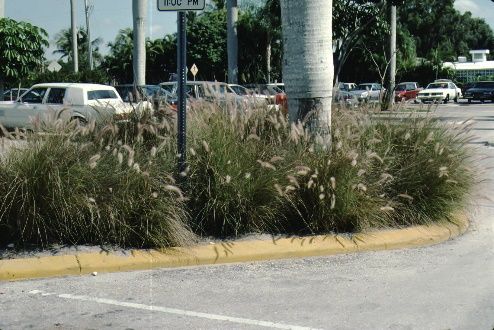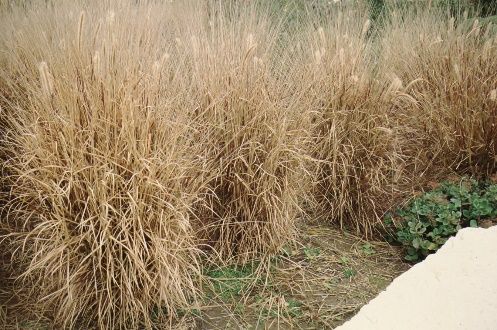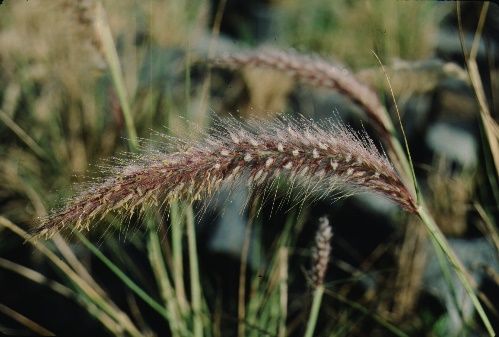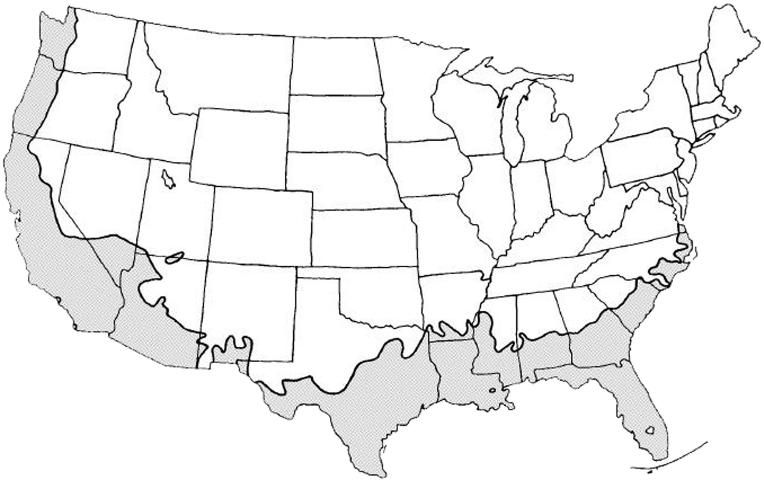Fountain Grass, Pennisetum setaceum is a FISC Category 2 Invasive plant in Florida. Information on this plant is being provided for identification in the landscape to encourage removal and identification at nurseries to discourage purchase.
Introduction
Fountain grass is an ornamental grass that is used in the landscape for its fine-textured foliage and showy flowers. Some catalogues refer to the plant as Pennisetum rupelii. The leaves of this 3 to 4 foot tall plant are narrow, curving, linear blades with a beautiful light green cast. The light purple to pink colored inflorescence of fountain grass sits atop a hollow, 3 foot long, nodding flower stalk. Flowers appear almost white in bright light. The feathery inflorescence is 12 inches long and occurs from early summer to frost. The fruits of this grass are small seeds that volunteer to form small plantlets nearby; this plant is considered mildly invasive if planted near undisturbed natural areas. The invasive habit is likely to be much less a problem in an urban landscape.

Credit: Edward F. Gilman, UF/IFAS

Credit: Edward F. Gilman, UF/IFAS

Credit: Edward F. Gilman, UF/IFAS
General Information
Scientific name: Pennisetum setaceum
Pronunciation: pen-niss-SEE-tum set-TAY-see-um
Common name(s): fountain grass, tender fountain grass, crimson fountain grass
Family: Poaceae
Plant type: ornamental grass; herbaceous
USDA hardiness zones: 8 through 10 (Figure 4)
Planting month for zone 8: year-round
Planting month for zone 9: year-round
Planting month for zone 10 : year-round
Origin: not native to North America
Invasive potential: potentially invasive
Uses: mass planting; container or above-ground planter; accent; border; cut flowers
Availability: generally available in many areas within its hardiness range

Credit:
Description
Height: 4 to 6 feet
Spread: 2 to 4 feet
Plant habit: upright
Plant density: moderate
Growth rate: fast
Texture: fine
Foliage
Leaf arrangement: most emerge from the soil, usually without a stem
Leaf type: simple
Leaf margin: entire
Leaf shape: linear
Leaf venation: parallel
Leaf type and persistence: deciduous
Leaf blade length: 18 to 36 inches
Leaf color: green
Fall color: brown or tan
Fall characteristic: showy
Flower
Flower color: white
Flower characteristic: summer flowering; fall flowering
Fruit
Fruit shape: unknown
Fruit length: unknown
Fruit cover: unknown
Fruit color: unknown
Fruit characteristic: inconspicuous and not showy
Trunk and Branches
Trunk/bark/branches: typically multi-trunked or clumping stems
Current year stem/twig color: not applicable
Current year stem/twig thickness: not applicable
Culture
Light requirement: plant grows in full sun
Soil tolerances: acidic; slightly alkaline; sand; loam; clay
Drought tolerance: moderate
Soil salt tolerances: unknown
Plant spacing: 36 to 60 inches
Other
Roots: not applicable
Winter interest: no special winter interest
Outstanding plant: plant has outstanding ornamental features and could be planted more
Pest resistance: no serious pests are normally seen on the plant
Use and Management
Fountain grass is a valuable accent or specimen plant that may be used around a fountain for the cooling silhouette it presents. This plant is also lovely when planted in mass, and it makes a nice accent in a border. Flowers can be cut for fresh arrangements, but they fall apart as they dry, making them unsuited for dry arrangements.
Fountain grass should be planted on a well-drained site that is exposed to full sun. Plants grow poorly in the partial shade and droop over. This grass is grown as a perennial in most of Florida (zones 8 through 10) but is an annual in cooler climates. Foliage will die back in north Florida in winter but will reappear in spring if the winter is mild. It is only moderately drought tolerant.
The cultivar 'Rubrum', also known as `Cupreum', has reddish foliage and flowers. 'Rubrum Dwarf' grows 2.5 to 3 feet tall.
Pests and Diseases
No pests or diseases are of major concern.